#molly macarthur
Text
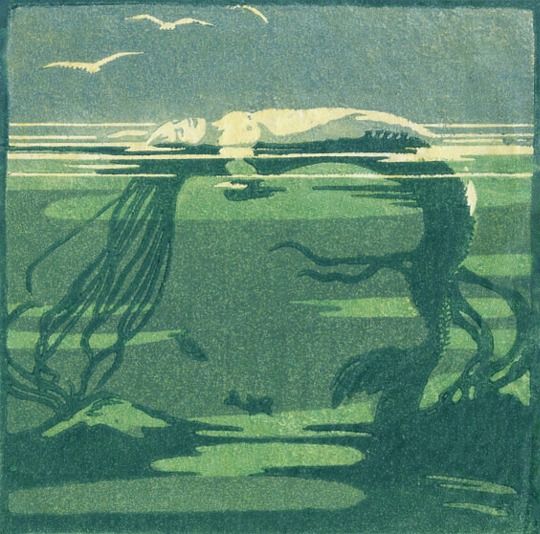
The Sleeping Mermaid
Artist : Florence Mary Anderson
#florence anderson#florence mary anderson#molly macarthur#mermaid#sleeping mermaid#sirène#woodcut print#sea gulls#mouettes#sea#mer#green#vert#long hair
4K notes
·
View notes
Photo

Art by Florence Mary Anderson widely known as Molly MacArthur (1893 - 1972)
789 notes
·
View notes
Text

Rosalind Russell and Cary Grant in His Girl Friday (Howard Hawks, 1940)
Cast: Cary Grant, Rosalind Russell, Ralph Bellamy, Gene Lockhart, Porter Hall, Ernest Truex, Cliff Edwards, Clarence Kolb, Roscoe Karns, John Qualen, Helen Mack, Billy Gilbert. Screenplay: Charles Lederer, based on a play by Ben Hecht and Charles MacArthur. Cinematography: Joseph Walker. Art direction: Lionel Banks. Film editing: Gene Havlick. Music: Sidney Cutner, Felix Mills.
I can never make a list of my ten favorite movies because once I get started I keep remembering the ones that absolutely have to be on the list. But His Girl Friday always claims a place somewhere, higher or lower. It's a movie without which life would be just a little poorer. The play on which it's based, The Front Page, was no slouch to start with. Ben Hecht and Charles MacArthur crafted the single best portrait of what it might have been like -- according to the accounts of others -- to be a newspaper reporter in the first half of the twentieth century, when there was neither television nor the internet to make one's profession obsolescent. We don't have to believe that it was always like that, but just that occasionally reporters in the big cities had moments like the ones shown in the movie. And then Charles Lederer, with uncredited help from Hecht, Howard Hawks, Morrie Ryskind, and a cast skilled at ad libbing, turned it into a romantic screwball comedy by changing the sex of one of the leads, Hildy Johnson, from male to female. And after lots of actresses who would have been just fine in the part (Katharine Hepburn, Carole Lombard, Irene Dunne, Jean Arthur) turned it down, Hawks cast Rosalind Russell in probably her greatest role. Is there a better matched team than Russell's Hildy and Cary Grant's Walter Burns? We can see both why they got divorced and why they could never be separated. And adding Ralph Bellamy as the patsy was a masterstroke, even though it's essentially the same role he had played three years earlier in The Awful Truth (Leo McCarey, 1937): the stuffy guy who loses out to Grant, perhaps because, as Burns observes, "He looks like that guy in the movies, you know ... Ralph Bellamy." The whole thing moves so brilliantly fast that you don't have time to reflect on the film's flaws, which include a racist gag about "pickaninnies" and a deep confusion about whether it's satirizing or valorizing its characters' callous indifference to other human beings -- notably the moment when Hildy sardonically refers to her fellow reporters as "Gentlemen of the press" after their harassment of Mollie Malloy (Helen Mack), but then immediately reverts to get-the-story-at-any-price behavior. What keeps it all skimming swiftly above reality is the astonishing skill of the leads (notice how long some of the takes are to realize how great their timing and command of dialogue was) and a gallery of great character players: Gene Lockhart, Roscoe Karns, John Qualen, and especially the hilarious Billy Gilbert as Joe Pettibone: If you can tear your eyes away from him long enough, watch how hard Grant and Russell are working to keep from cracking up at his performance. Oh, hell, stop whatever you're doing and just go watch it.
4 notes
·
View notes
Photo

The Big Fig got a new puppy & Goggles got a new roomie, Winnie. She’s so sweet. Getting ready for the last Cabin weekend required specific snacks & vegan marshmallows. Had some girl time with Molly. Yummy new sandwich spot on MacArthur caked Saints. Quality time with Hazel, the Keno whisperer, too. #lifeisgood (at The Big Fig) https://www.instagram.com/p/CkAYZ1dr9eCJrb_bLTmKqb90t6urQD4rkFkJ9s0/?igshid=NGJjMDIxMWI=
0 notes
Note
6, 17, 26, and 30 for the music ask! :D
6. your current “on repeat” song
i have been loving the new alvvays album in general but every time i put it on i get excited when i get to very online guy. weirdly didn’t hit for me as a single but as soon as i heard it in the context of the album i was like wait. this one fucking rules ahdjfkfks the production is so cool and i love molly rankin’s vocal performance she sounds so over it
17. a song that reminds you of a good time
if this tour doesn’t kill you i will by pup makes me think of walking around campus w my roommate freshman year :’ ) i love them and i love this song i love that the band talks about it as being an ode to friendship bc literally what is friendship if not spending so much time together that you’re sick of each other shdjfk
26. a song that taught you a lesson
barbara macarthur’s spanish alphabet song taught me the alphabet in spanish
30. your all-time favorite song
this is an impossible question but one of the very top contenders is housekeyz by field medic which earns this shoutout bc i was talking to u about how i want a tattoo based on it : ) shoutout mr medic
#i saw pup like a month ago they were soooo good#ty cola my angel!!!!#for the asks and for rbing this ask meme leading me to see it it’s cute#ask tag
1 note
·
View note
Photo
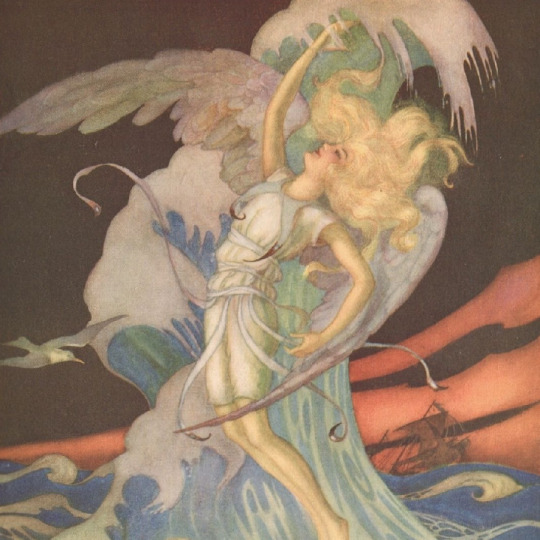
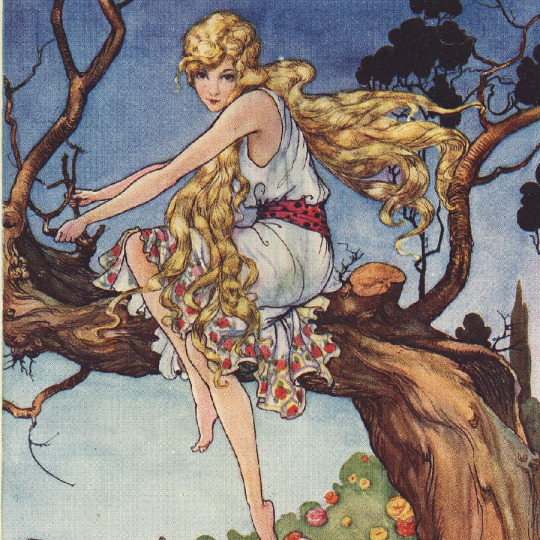

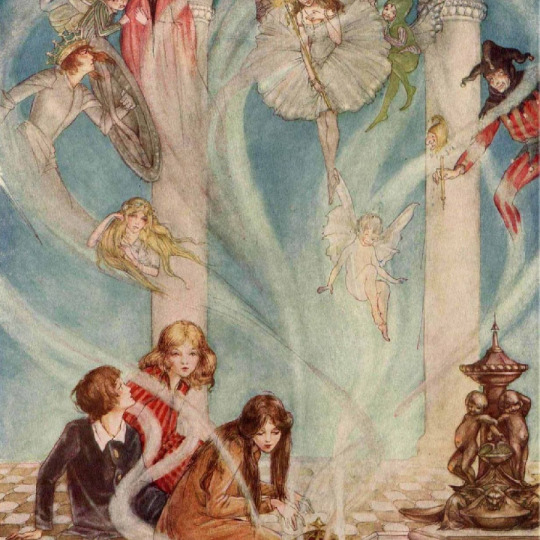


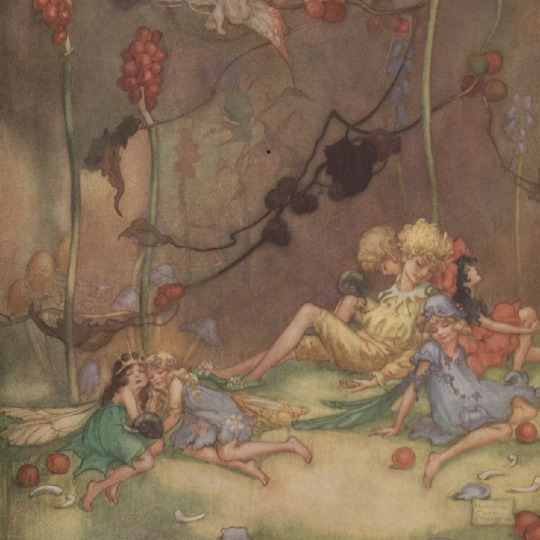
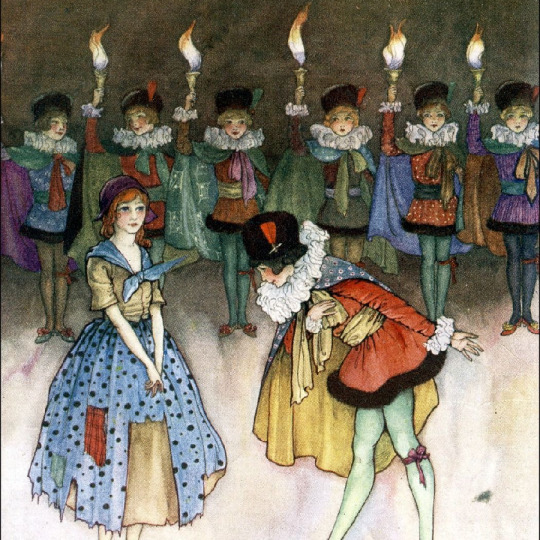

Artist I Like Series
Molly MacArthur/Florence Mary MacArthur/Florence Mary Anderson 1893-1972 was an English artist and stage designer who also illustrated a number of books. Her work for the stage (always as Molly MacArthur) was first seen in 1923, after which she worked in the theatre continuously until 1958.
#Florence Mary MacArthur#Molly MacArthur#Florence Mary Anderson#20th century art#female artists#English#illustrator#artist I like#art history#art#art inspo#fave
53 notes
·
View notes
Photo
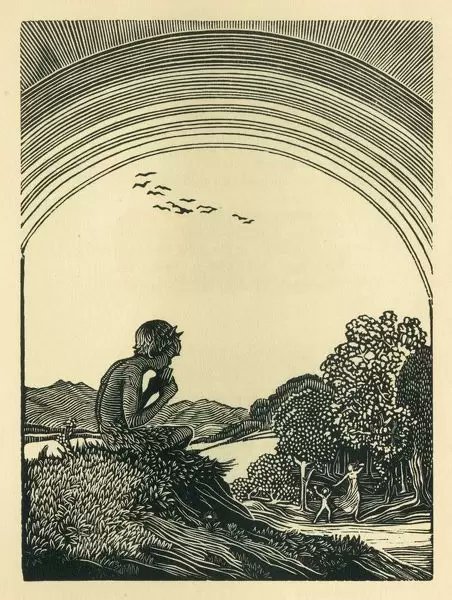
Molly MacArthur @ElliottBlackwe3
44 notes
·
View notes
Text
#730: 'His Girl Friday', dir. Howard Hawks, 1940.
One of the pre-eminent screwball comedies, His Girl Friday is a fascinating example of adaptation. It also demonstrates how Howard Hawks was fine-tuning the screwball comedy after his earlier experiences with Bringing Up Baby the year before. What this film shows above all else is the malleability of the original material, but also the significant changes in meaning and subtext that happen when the source is changed to this degree.

On paper, the change is simple: switch the gender of one of the two protagonists. Ben Hecht and Charles MacArthur's play The Front Page revolves around two newspaper reporters, Hildy Johnson and Walter Burns, embroiled in a prison break plot when the escaped convict hides out in the press room where Johnson is saying his farewells to the other reporters. During the casting for the role of Burns, though, Howard Hawks' secretary read Johnson's dialogue to the hopeful actors, and Hawks decided he preferred the sound of the fast banter coming from a woman. Rewrites were undertaken, partly by Ben Hecht, but mostly by Charles Lederer, who had also adapted The Front Page straightforwardly for an earlier film.
I find this one of the most fascinating aspects of any adaptation: a director must usually pick something to adapt because of the overall quality of the work, but the process of adaptation almost always results in vast sections of the work being completely changed. In this case, half of the dialogue from the play which Hawks loved so much was replaced in the film script by Hecht and Lederer's later work, which was then further augmented by the frequent improvisations of the actors (and by a screenwriter that Rosalind Russell hired to provide her with extra material). The film includes a number of scenes outside of the press room as well: now that Hildy Johnson is a woman, the typical screwball comedy plot comes into play. Hildy and Walter are now ex-spouses, and while Hildy getting married is also the impetus of his resignation in The Front Page, in His Girl Friday the impending wedding is Walter's chief reason to prevent Hildy from leaving. Because of this, the character of the fiance has to be brought into greater detail, and on and on it goes. Multiple scenes have to take place, in the newsroom, in the police station, and in the restaurant, to lay this necessary groundwork, and it's quite impressive that Hawks and the writers felt strongly enough about this film to put that work in.
But when the film's plot finally comes into alignment with the play, it's nothing short of spectacular, and its roots in stage theatre are much more visible, and admirably so. Hawks wanted this film to replicate the real-life speed of talking, with overlapping dialogue, and I found this so effective that it was hard to look away from the screen even for a few seconds, otherwise I was liable to lose track of where the conversation had moved. There's something in particular about the court-adjacent settings that works brilliantly for stage adaptation, as they're a space that action occupies for a short but intense time. In the case of His Girl Friday, this action is accompanied by a Greek chorus of reporters for other newspapers, who squabble and comment on the events, and provide good counterpoints to the behaviour of our protagonists (when the escaped prisoner is finally captured after handing himself in without a fight, the other reporters start filing articles about a dramatic shootout).
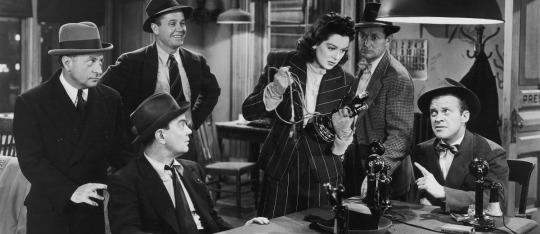
His Girl Friday isn't a perfect film to a modern sensibility, though. I've often said that my feelings on Singin' in the Rain keep cooling as I watch it more, because the treatment of Lina Lamont gets worse but my favourite parts never get better. His Girl Friday has many of the same issues, as a lot of Walter's attempts to get Hildy's fiance, Bruce (Ralph Bellamy, who I'm mentioning because of an excellent throwaway joke about him) rely on making Hildy look neglectful or criminal. It's not about sending Bruce away to do something more important to him (Walter could easily concoct a reason to stall an insurance agent for a while), but about driving a wedge between Bruce and Hildy (having Hildy inadvertently give Bruce counterfeit money, for example, and gaslighting Hildy's potential mother-in-law).
The film admittedly does have some insightful things to say about gender - the man's power is not to have it all, in this film, but to be able to devote himself totally to his job while women have to fight with an internal desire to have both a career and a personal life - but the ending does ring on a sour note, much in the same way that Singin' in the Rain does. In many screwball comedies, it seems, love does eventually win out, but it does so in spite of the characters rather than because they change or develop. The end of His Girl Friday leaves us in the same place as we were at the start, and the characters are still the same, more or less, but now they're back in love. It's debatable whether Hildy actually sees how little Walter cares for her, and whether he's read her anxiety over being forced out of her career by marriage as just another sign she actually loves him. If so, this film ends on a decidedly downbeat note, where Hildy gets everything she wants but none of the happiness that's supposed to attend it.
This film also indicates just how rough studio Hollywood actually played when it was in the service of 'comedy'. As well as the treatment of Hildy, this film also includes Mollie Malloy (Helen Mack) jumping from an upstairs window to keep the location of the escaped prisoner safe. The film practically glances off this near-suicide and never mentions Mollie again - water off a duck's back as the plot continues motoring indefatiguably ahead.
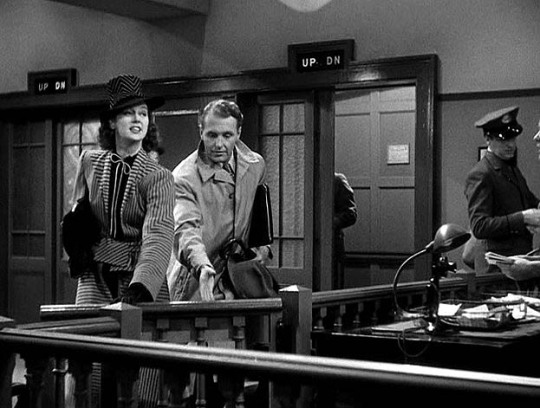
This darkness isn't meant as a strong criticism, just as an acknowledgement that the past did things differently and that it frequently didn't treat some issues with the respect they deserved. Knowing that going in means that you can watch for those issues rather than having them destroy your enjoyment of the film. Because if you can step around those little hiccups, then His Girl Friday is the most entertaining and amusing of all Dumpster-fires (and I mean that as the highest possible praise).
13 notes
·
View notes
Photo


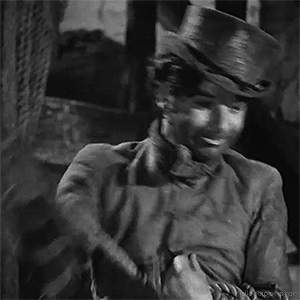
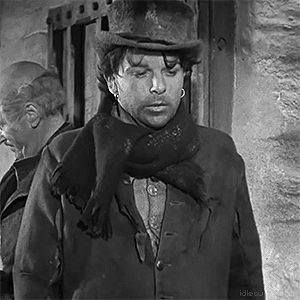
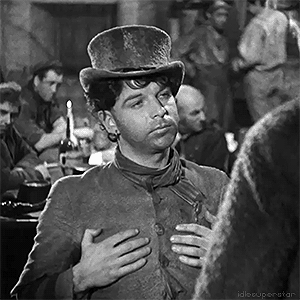




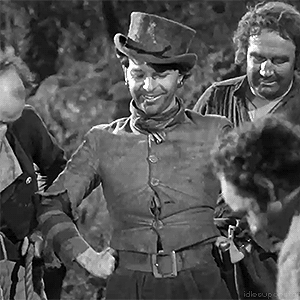
I’d like to thank Molly MacArthur* for designing this flipping tremendous punk-ass outfit that the marvellous Emlyn Williams gets to wear as Harry the Pedlar in Jamaica Inn [Hitchcock, 1939]
*Molly MacArthur designed extensively for the stage, including for Tyrone Guthrie in the 30s at the Old Vic. This was her only film work.
#emlyn williams#jamaica inn#so charles laughton was at the old vic in 33-34 and I'm wondering if he got molly for this job#as his production company mayflower produced this#it's weird that she only did one film ever#anyway STRIPEY PUNK JUMPER EMLYN FTW#he's so good at playing bad guys#so I am going to try and post a new gifset every day this week#I"m setting myself lockdown goals#let's see how long I last#this has been in drafts for like months#my wee gifs
54 notes
·
View notes
Text
CINDY SHERMAN
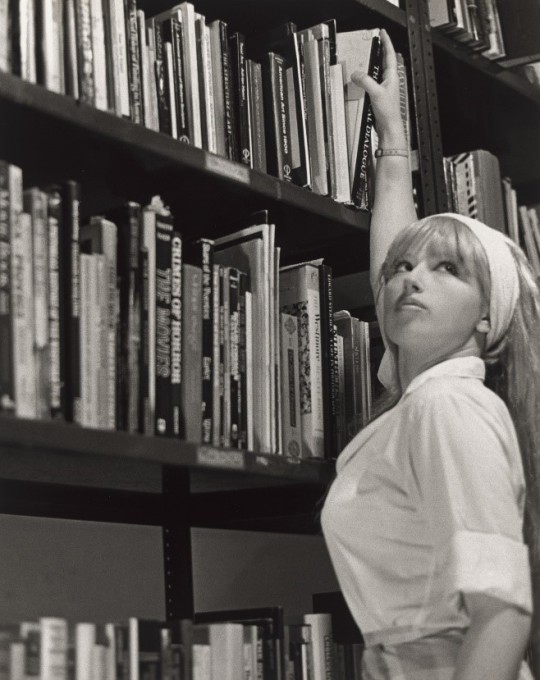
Cindy Sherman Untitled Film Still #13 (1978)
https://www.vogue.co.uk/arts-and-lifestyle/article/cindy-sherman-louis-vuitton-fondation
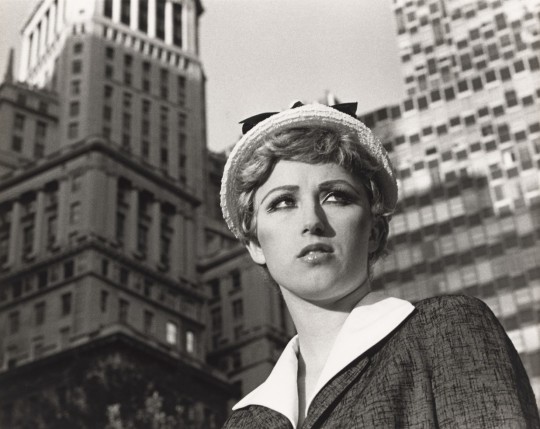
Cindy Sherman Untitled Film Still #21 (1978)
https://drnorth.wordpress.com/2011/05/28/picture-of-the-week-77-cindy-shermans-film-stills/#jp-carousel-7513
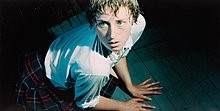
Cindy Sherman Untitled #92, "Disasters and Fairy Tales" Series (1985)
https://www.moma.org/calendar/exhibitions/1038

Cindy Sherman Untitled #209, "History Portrait" Series (1989)
http://juliettebuck.blogspot.com/2012/04/cindy-sherman.html
Biography of Cindy Sherman
Childhood Cindy Sherman was born January 19, 1954 in Glen Ridge, New Jersey (virtually a suburb of New York City). Shortly after Cindy's birth, the family moved to Huntington, Long Island, where Cindy grew up as the youngest of five children. Although her parents shared a general disinterest in the arts-her father was an engineer and her mother a reading teacher-Sherman chose to study art in college, enrolling at the State University of New York, at Buffalo, in the early 1970s. Early Training
Sherman studied in Buffalo from 1972-76; she began as a painter, but she quickly found herself frustrated by what she considered certain limitations of the medium. The 1970s was an eclectic era for painters working in the aftermath of Minimalism, and feeling as though "there was nothing more to say [through painting]," Sherman shifted her attention to photography. Although initially failing a required photography class, she later elected to repeat the course, which ignited her passion for the subject. During her studies, Sherman met fellow artists Robert Longo and Charles Clough, with whom she co-founded Hallwalls Center for Contemporary Art in 1974 (it continues to function to the present day as a dynamic, multi-arts "hub"). Longo and Sherman dated until 1979. During her studies, Sherman was exposed to Conceptual art and other progressive art movements and media under the widely influential art instructor, Barbara Jo Revelle.
Upon graduation, Sherman moved to New York City to pursue her artistic career. In 1977, with her downtown residential and studio loft as her primary backdrop, Sherman began taking a series of photographs of herself, a project she would eventually refer to as the Untitled Film Stills. In this series, Sherman embodies the character of "Everywoman." Re-fashioning herself repeatedly into the guise of various female archetypes, Sherman played the girly pin-up, the film noir siren, the housewife, the prostitute, and the noble damsel in distress. The black-and-white series occupied her for about three years, so that by 1980 Sherman had virtually exhausted a myriad of seemingly timeless clichés referring to the "feminine."
Mature Period
With the debut of Untitled Film Stills, Sherman secured her position in the New York art world, leading to her first solo show at the non-profit exhibition space, The Kitchen. Shortly after, she was commissioned to create a centrefold image for Artform magazine. Photos of a pink-robe-clad Sherman were ultimately deemed too racy by editor Ingrid Sischy and rejected. There is no knowing whether a subsequent series shot from 1985 to 1989, Disasters and Fairy Tales, was in some sense a response to that act of rejection, but, notably, it is a much darker endeavour than its prettified predecessor. Its gloomy palette and scenes strewn with vomit and mould challenged viewers to find beauty in the ugly and the unqualified grotesque.
Sherman's next series took on the hallowed subject of the art tableau. History Portraits again presented Sherman-as-model, but this time she assumed the air of European art history's most famous "leading ladies." Living in Europe at the time of its creation, Sherman drew inspiration from the West's great museums. That interlude gave way, in 1992, to Sherman's Sex Pictures, a project taken up in response to the censorship of the art of Robert Mapplethorpe and Andres Serrano. In the Sex Pictures, Sherman substituted her own figure for that of a doll. Intending to shock and scandalize the public, the images present close-ups of doll-on-doll sex scenes and prosthetic genitalia. Shortly after she began work on this series, Sherman received a MacArthur Fellowship.
In 1997, Sherman crossed over from still art photography to motion pictures, aided in part by her husband at that time, film director Michel Auder (the two divorced in 1999). She made her directorial debut with the thriller, Office Killer, starring Molly Ringwald and Jeanne Tripplehorn. A year later, Sherman played herself in John Waters's 1998 comedy, Pecker.
Over the last decade, Sherman done clown's make-up in a series of still photography (2003) and, even more recently, she explored carefully staged female "suburban" identities in a solo show at Metro Pictures, NY (2008). In the latter series, Sherman photographed herself in various states of awkward make-up, superimposing stodgy, highly self-conscious portraits over contrived domestic and faux-monumental backdrops. In 2006, Sherman was honoured by a retrospective of her work at the Jeu de Paume Museum, in Paris. Sherman continues to live and work in New York City, where she is dating David Byrne, of the band, "Talking Heads." She celebrated a solo exhibition at MoMA in early 2012.
The Legacy of Cindy Sherman
The ultimate participant-critic of mass consumer culture, one perpetually partaking of its daily realities while nonetheless challenging its underlying assumptions, Cindy Sherman epitomizes the 1980s technique of "image-scavengering," and "appropriation" by artists seeking to question the so-called truth potential of mass imagery and its seductive hold on our individual and collective psyches. Sherman's depersonalized approach to portrait photography has suggested a new, socially critical capacity for a medium that was once presumed a tool of documentary realism (or aesthetic pleasure). This "readymade" quality of the critically applied photograph, whereby a pre-existing image or convention is appropriated intact by the artist and subtly turned into something more conceptually problematic, if not psychologically disturbing, has come to characterize much work of a new generation defying easy categorization.
In addition, Sherman's work has been specifically cited as opening onto a new, "expanded field" of photography since the late 1990s, in much work characterized by a "fusion of narrative and stasis," such as in the photography of Jeff Wall, Anna Gaskell, Justine Kurland, Jenny Gage, and Sharon Lockhart. Such artists extend Sherman's anti-narrative approach to the medium and its subject matter, in work that frequently suggests unresolved stories and scenarios wrenched from contexts both common and disturbingly mysterious.
4 notes
·
View notes
Text

The Rainbow Twins
1919
written and illustrated by Florence Mary Anderson
#the rainbow twins#florence mary anderson#1919#castle in the sky#castle#sea#florence anderson#molly macarthur
182 notes
·
View notes
Photo

Upcoming 2020 Exhibitions
We’re pleased to announce a selection of upcoming 2020 exhibitions. This winter, we welcome back our iconic Kehinde Wiley painting Napoleon Leading the Army over the Alps (2005), which for the first time at the Brooklyn Museum will be presented in dialogue with its early nineteenth-century source painting, Jacques-Louis David’s Bonaparte Crossing the Alps (1801). We also look at our collection from new perspectives with focused exhibitions that present historical works through a contemporary, multifaceted lens. Out of Place: A Feminist Look at the Collection examines nearly 50 collection works using an intersectional feminist framework. Climate in Crisis: Environmental Change in the Indigenous Americas is an installation of the Museum’s Arts of the Americas collection which reconsiders indigenous art from the perspective of the prolonged and ongoing impact of climate change and colonization. Contemporary artist and MacArthur Fellowship recipient Jeffrey Gibson mines our collection and archives to examine collecting practices and reinterpret historical representations of indigenous communities. We also present African Arts—Global Conversations, a cross-cultural exhibition pairing diverse African works with collection objects made around the world, and Striking Power: Iconoclasm in Ancient Egypt, which examines the damage to sculptures and reliefs in ancient Egypt as a way of also exploring twenty-first-century concerns and struggles over public monuments and the destruction of antiquities.
In March, we celebrate the iconic history and trailblazing aesthetics of Studio 54 in a special exhibition featuring never-before-seen archival materials, video, photography, fashion, and more. We will also present the first solo museum exhibition dedicated to Brooklyn-based photographer John Edmonds, winner of our inaugural UOVO Prize for an emerging Brooklyn artist. And in the fall of 2020, we are proud to mount the first career retrospective of the work of Lorraine O’Grady, one of the most significant figures in contemporary performance, conceptual, and feminist art.
“We’re thrilled to present a roster of exhibitions next season that are in conversation with our collection in fresh and exciting ways,” says Anne Pasternak, Shelby White and Leon Levy Director, Brooklyn Museum. “As an encyclopedic museum, we’re always looking for new ways to examine our collection and open it up to include narratives that have historically been left out of the canon. In 2020, we’re committed to exhibitions that do just that: telling stories that are rarely told, through the eyes of contemporary artists.”

Jacques-Louis David Meets Kehinde Wiley
January 24–May 10, 2020
Morris A. and Meyer Schapiro Wing, 4th Floor
This exhibition brings an iconic painting from our collection—Kehinde Wiley’s Napoleon Leading the Army over the Alps (2005)—into dialogue with its early nineteenth-century source painting, Jacques-Louis David’s Bonaparte Crossing the Alps (1801). The two paintings, displayed together for the very first time, are on view in consecutive exhibitions at the Château de Malmaison from October 9, 2019, to January 6, 2020, and at the Brooklyn Museum from January 24 to May 10, 2020. This focused exhibition questions how ideas of race, masculinity, representation, power, heroics, and agency play out within the realm of portraiture. The presentation at the Brooklyn Museum is the first time David’s painting is on view in New York, and Wiley marks this momentous occasion by consulting on the exhibition design. It includes videos incorporating Wiley’s perspectives on how the Western canon, French portrait tradition, and legacies of colonialism influence his own practice. The exhibition represents an intimate conversation between two key artists of the nineteenth and twenty-first centuries and illuminates how images construct history, convey notions of power and leadership, and create icons.
The exhibition is organized by the Brooklyn Museum and Musée national des châteaux de Malmaison and Bois-Préau. The Brooklyn presentation is curated by Lisa Small, Senior Curator, European Art, and Eugenie Tsai, John and Barbara Vogelstein Senior Curator, Contemporary Art, Brooklyn Museum.

Out of Place: A Feminist Look at the Collection
January 24–September 13, 2020
Elizabeth A. Sackler Center for Feminist Art, 4th Floor
This exhibition presents more than 50 works from across our collections. Following the 2018 exhibition Half the Picture: A Feminist Look at the Collection, Out of Place also explores collection works anew through an intersectional feminist framework. Out of Place features more than forty artists from remarkably different contexts whose unconventional materials and approaches call for a broader and more dynamic understanding of modern and contemporary art.
Examining how contexts change the way we see art, Out of Place: A Feminist Look at the Collection showcases artists who have traditionally been seen as “out of place” in most major collecting museums. The exhibition is organized around three distinct cultural contexts for making and understanding creativity—museums and art spaces, place-based practices, and the domestic sphere—and explores significant histories that have been, until recently, overlooked and undervalued, despite their influence outside of the mainstream. Out of Place traces how cultural institutions are challenged and changed by the ways artists work. Over half of the works in the exhibition are on view for the very first time, including important collection objects as well as significant new acquisitions, such as highlights from the recent Souls Grown Deep Foundation Gift of works by Black artists of the American South.
Artists featured include Louise Bourgeois, Beverly Buchanan, Chryssa, Thornton Dial, Helen Frankenthaler, Lourdes Grobet, Louise Nevelson, Dorothea Rockburne, Betye Saar, Miriam Schapiro, Judith Scott, Joan Snyder, and May Wilson, among others.
Out of Place: A Feminist Look at the Collection is curated by Catherine Morris, Senior Curator for the Elizabeth A. Sackler Center for Feminist Art, and Carmen Hermo, Associate Curator, Elizabeth A. Sackler Center for Feminist Art. Generous support for this exhibition is provided by the Helene Zucker Seeman Memorial Exhibition Fund.

Jeffrey Gibson: When Fire Is Applied to a Stone It Cracks
February 14, 2020–January 10, 2021
Arts of the Americas Galleries, 5th Floor
This exhibition presents new and existing work by artist Jeffrey Gibson alongside a selection from our extensive collection and archives. Gibson collaborated with historian Christian Crouch to organize this exhibition that examines nineteenth- and early twentieth-century museum collecting practices, and the historical representations of indigenous communities, through a contemporary lens.
Gibson, an artist of Choctaw and Cherokee descent, often incorporates elements of Native American art and craft into his practice. He regards these aesthetic and material histories as modern, innovative, global, and hybrid. The presentation includes collection objects such as moccasins, headdresses, ceramics, and parfleche, and examples of beadwork and appliqué, displayed alongside Gibson’s contemporary works, which take material and formal inspiration from these traditional artistic practices. The exhibition also includes rarely exhibited items from our archives that shed light on the formation of the Brooklyn Museum’s Native American collection in the early twentieth century by curator Stewart Culin. The archival selections by Gibson and Crouch aim to return the focus to the indigenous individuals represented within the archives, recovering those individuals’ previously overlooked narratives and presence.
By presenting his own work alongside key selections from our collection, Gibson offers a different perspective on historical objects within a museum setting—one that is not static or stuck in the past, but ever evolving and modern. He encourages visitors to question long-held categorizations and representations of Native American art and challenges our understanding of tradition, practice, craftsmanship, and art-making.
Jeffrey Gibson: When Fire Is Applied to a Stone It Cracks is organized by Jeffrey Gibson and Christian Crouch, Curatorial Advisor, with Eugenie Tsai, John and Barbara Vogelstein Senior Curator, Contemporary Art, and Erika Umali, Mellon Curatorial Fellow, with support from Nancy Rosoff, Andrew W. Mellon Senior Curator, Arts of the Americas, and Molly Seegers, Museum Archivist, Brooklyn Museum. Major support for this exhibition is provided by Ellen and William Taubman. Generous support is provided by the Brooklyn Museum’s Contemporary Art Committee, the FUNd, and Stephanie and Tim Ingrassia.
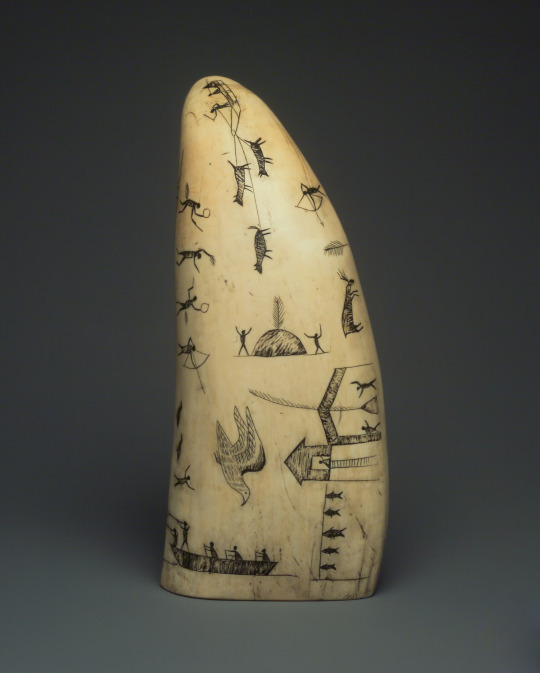
Climate in Crisis: Environmental Change in the Indigenous Americas
February 14, 2020–January 10, 2021
Arts of the Americas Galleries, 5th Floor
Climate change is having a severe impact on indigenous communities across the Americas, but this situation has an even longer history. The European conquest and colonization of the Americas beginning in the sixteenth century introduced ways of using and exploiting natural resources that clashed with indigenous ways of understanding and relating to the natural world. This exhibition draws upon the strength of our renowned collection to highlight indigenous worldviews about the environment, and the ongoing threat of ecological destruction.
The installation includes work spanning 2,800 years, and explores how indigenous beliefs, practices, and ways of living are impacted by the climate crisis, ranging from the effects of melting sea ice and overfishing for Native peoples of the Arctic and Pacific Northwest to illegal logging and deforestation for indigenous communities in the Amazon. This environmental perspective reveals the fundamental disparities between the misuse of natural resources over the past five hundred years and indigenous communities’ profound relationships with their ancestral homelands. In addition, the exhibition incorporates voices of contemporary indigenous activists to underscore the work being done today to counter the climate crisis and protect the planet.
Climate in Crisis: Environmental Change in the Indigenous Americas is curated by Nancy Rosoff, Andrew W. Mellon Senior Curator, Arts of the Americas, with Joseph Shaikewitz and Shea Spiller, Curatorial Assistants, Arts of the Americas and Europe.

African Arts—Global Conversations
February 14–November 15, 2020
Lobby Gallery, 1st Floor, and collection galleries on the 2nd, 3rd, and 5th Floors
African Arts—Global Conversations seeks to bring African arts into broader, deeper, and more meaningful and critical conversations about the ways that art history and encyclopedic museums have or have not included African artworks. It is the first exhibition of its kind to take a transcultural approach pairing diverse African works across mediums with objects made around the world―all drawn from our collection. It puts African and non-African arts from distinct places and time periods in dialogue with each other in an introductory gallery, as well as in “activation spaces” in the galleries dedicated to European Art, Arts of the Americas, American Art, Ancient Egyptian Art, and Arts of Asia. Duos, trios, and other groupings of objects from a wide variety of locations worldwide prompt conversations about history, art, race, power, design, and more. Approximately 33 artworks are presented (including 20 by African artists), as well as a selection of historical books. Highlights include the celebrated eighteenth-century sculpture of a Kuba ruler, a selection of fourteenth- to sixteenth-century Ethiopian Orthodox processional crosses, and a midtwentieth-century mask from Sierra Leone’s Ordehlay (Ode-Lay) society. Also on view are works by contemporary artists Atta Kwami, Ranti Bam, Magdalene Odundo OBE, and Taiye Idahor.
African Arts—Global Conversations is curated by Kristen Windmuller-Luna, Sills Family Consulting Curator, African Arts, Brooklyn Museum.

Studio 54: Night Magic
March 13–July 5, 2020
Morris A. and Meyer Schapiro Wing and Iris and B. Gerald Cantor Gallery, 5th Floor
Studio 54: Night Magic is the first exhibition to trace the groundbreaking aesthetics and social politics of the historic nightclub, and its lasting influence on nightclub design, cinema, and fashion. Though it was open for only three years—from April 26, 1977, to February 2, 1980—Studio 54 was arguably the most iconic nightclub to emerge in the twentieth century. Set in a former opera house in Midtown Manhattan, with the stage innovatively re-envisioned as a dance floor, Studio 54 became a space of sexual, gender, and creative liberation, where every patron could feel like a star. From the moment Studio 54 opened, its cutting-edge décor and state-of-the-art sound and lighting systems set it apart from other clubs at the time, attracting artists, fashion designers, musicians, and celebrities whose visits were vividly chronicled by notable photographers. In addition to presenting the photography and media that brought Studio 54 to global fame, the exhibition conveys the excitement of Manhattan’s storied disco club with more than 600 objects ranging from fashion design, drawings, paintings, film, and music to décor and extensive archives.
Studio 54: Night Magic is curated and designed by Matthew Yokobosky, Senior Curator of Fashion and Material Culture, Brooklyn Museum. Lead sponsorship for this exhibition is provided by Spotify.

John Edmonds: A Sidelong Glance
May 1, 2020–February 7, 2021
Stephanie and Tim Ingrassia Gallery of Contemporary Art, 4th Floor
John Edmonds is the first winner of the UOVO Prize, a new annual award for an emerging artist living or working in Brooklyn. This is Edmonds’s first solo museum exhibition and features approximately 25 new and recent photographic works that include portraiture and still lifes of Central and West African sculptures. Best known for his sensitive depictions of young Black men, Edmonds uses photography and video to create formal pictures that challenge art historical precedents and center Black queer desire. He often uses a large-format camera to heighten the staging of his subjects and explore their sculptural potential, making reference to religious paintings and modernist photography. Highlighting markers of Black self-fashioning and community— hoodies, du-rags, and more recently, African sculptures— Edmonds’s works point to individual style and a shared visual language across time.
John Edmonds: A Sidelong Glance is curated by Ashley James, former Assistant Curator, Contemporary Art, and Drew Sawyer, Phillip Leonian and Edith Rosenbaum Leonian Curator, Photography, Brooklyn Museum. Leadership support for the UOVO Prize is provided by UOVO.
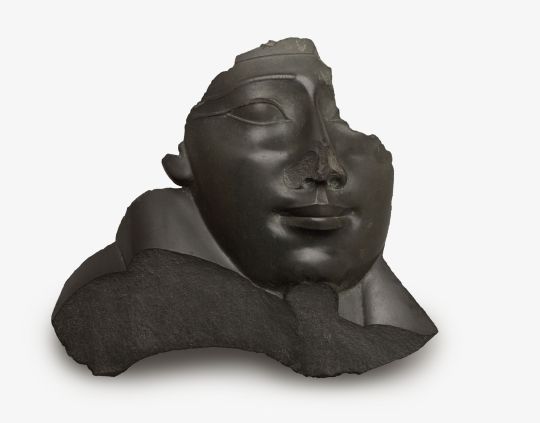
Striking Power: Iconoclasm in Ancient Egypt
Opening May 22, 2020
Egyptian Galleries, 3rd Floor
This exhibition, which draws from our renowned Egyptian collection, seeks to establish a context for considering contemporary concerns and struggles over public monuments and damage to antiquities. Striking Power: Iconoclasm in Ancient Egypt explores patterns of organized campaigns of destruction to sculptures and reliefs motivated by shifting ideologies, politics, and crime in ancient Egypt, over a 2,500-year period. Presenting approximately 60 whole and damaged masterpieces of Egyptian art, the exhibition explores the damage that occurred during and after the rule of Pharaohs, with particular focus on the contested reigns of Hatshepsut (circa 1478–1458 B.C.E.) and Akhenaten (circa 1353–1336 B.C.E.). Targeted damage to sculptures typically occurred around a figure’s nose, which ancient Egyptians believed would remove the sculpture’s supernatural ability to breathe and therefore prevent the deceased figure from interacting with the human world. The exhibition explores the notion of public approval of iconoclasm and poses the question, who has the power to bring down or destroy images? Opinions about iconoclasm hinge on questions of whose narrative dominates public space. Many of the same questions about public art that concern the contemporary world, such as the role that U.S. Confederate monuments should play in today’s publically shared spaces, are illuminated through the lens of ancient iconoclasm.
Striking Power: Iconoclasm in Ancient Egypt is organized in collaboration with the Pulitzer Arts Foundation and is curated by Edward Bleiberg, Senior Curator of Egyptian, Classical, and Ancient Near Eastern Art, Brooklyn Museum.

Lorraine O’Grady: Both/And
November 20, 2020–April 11, 2021
Elizabeth A. Sackler Center for Feminist Art, 4th Floor
Lorraine O’Grady: Both/And is the first comprehensive retrospective of one of the most significant figures in contemporary performance, conceptual, and feminist art. For four decades, from the anger and hilarity of the early guerrilla performance Mademoiselle Bourgeoise Noire, to the joy and complexity of Art Is… on Harlem’s streets, to the haunting alternations in her single-channel video Landscape (Western Hemisphere), O’Grady has delved fearlessly into a range of timely questions: Black subjectivity (especially Black female subjectivity), diaspora, hybridity, art’s guiding concepts and institutions (from modernism to the museum), and the intersection of self and history. By putting contradictory ideas into play—black and white, self and other, here and there, West and non-West, past and present—and allowing them to interact with each other without expecting a concrete resolution, O’Grady’s work aims to replace the dualistic, “either/or” of Western thought with a productive, open-ended “both/and.” The urgency of the ideas she explores is perhaps the reason that her work is being newly embraced by a younger generation of artists who find much to learn from a practice that upends the fixed positions of power that structure our culture—while bringing into focus the poignancy of the lives that have been lived within these frameworks.
The exhibition includes twelve of the artist’s fourteen major projects, accompanied by a selection of material from her rich archive. It is accompanied by a catalogue documenting the full span of O’Grady’s artistic career, the first publication to do so, with essays by Malik Gaines, Harry Burke, Zoe Whitley, Catherine Morris, and Aruna D’Souza, along with a conversation between O’Grady and Catherine Lord.
Lorraine O’Grady: Both/And is organized by Catherine Morris, Senior Curator for the Elizabeth A. Sackler Center for Feminist Art, Brooklyn Museum, and writer Aruna D’Souza. Leadership support for this exhibition is provided by The Kaleta A. Doolin Foundation. Major support is provided by the Elizabeth A. Sackler Museum Educational Trust. Generous support is provided by Shelley Fox Aarons and Philip Aarons.
We hope to see you at the Museum soon!
Illustrated, from top:
Rose Hartman (American, born 1937). Bianca Jagger Celebrating her Birthday, Studio 54, 1977. Black and white photograph. Courtesy of the artist. © Rose Hartman
Kehinde Wiley (American, born 1977). Napoleon Leading the Army over the Alps, 2005. Oil on canvas. Brooklyn Museum, Partial gift of Suzi and Andrew Booke Cohen in memory of Ilene R. Booke and in honor of Arnold L. Lehman, Mary Smith Dorward Fund, and William K. Jacobs, Jr. Fund, 2015.53. © Kehinde Wiley. (Photo: Brooklyn Museum)
Lourdes Grobet (born Mexico City, Mexico, 1940). Untitled, from the series Painted Landscapes, circa 1982. Silver dye bleach photograph. Brooklyn Museum; Gift of Marcuse Pfeifer, 1990.119.12. © Maria de Lourdes Grobet. (Photo: Brooklyn Museum)
Jeffrey Gibson (American, born 1972). WHEN FIRE IS APPLIED TO A STONE IT CRACKS, 2019. Acrylic on canvas, glass beads and artificial sinew inset into custom wood frame. Courtesy of the artist and Kavi Gupta, Chicago. © Jeffrey Gibson. (Photo: John Lusis)
Eskimo artist. Engraved Whale Tooth, late 19th century. Sperm whale tooth, black ash or graphite, oil. Brooklyn Museum; Gift of Robert B. Woodward, 20.895. Creative Commons-BY. (Photo: Brooklyn Museum)
Kuba artist. Mask (Mwaash aMbooy), late 19th or early 20th century. Rawhide, paint, plant fibers, textile, cowrie shells, glass, wood, monkey pelt, feathers. Brooklyn Museum; Robert B. Woodward Memorial Fund, 22.1582. (Photo: Brooklyn Museum)
Guy Marineau (French, born 1947). Pat Cleveland on the dance floor during Halston's disco bash at Studio 54, 1977. (Photo: Guy Marineau / WWD / Shutterstock)
John Edmonds (American, born 1989). Two Spirits, 2019. Archival pigment photograph. Courtesy of the artist and Company, New York. © John Edmonds
Face and Shoulder from an Anthropoid Sarcophagus, 332–30 B.C.E. Black basalt. Brooklyn Museum; Charles Edwin Wilbour Fund, 37.1516E. (Photo: Brooklyn Museum)
Lorraine O'Grady (American, born 1934). Rivers, First Draft: The Woman in the White Kitchen tastes her coconut, 1982/2015. Digital chromogenic print from Kodachrome 35mm slides in 48 parts. Courtesy Alexander Gray Associates, New York. © Lorraine O’Grady/Artists Rights Society (ARS), New York
#brooklyn#studio54bkm#studio54#Kehinde Wiley#DavidxWiley#feminist art#jeffrey gibson#globalconversations#climate change#indigeneous art#native american#native american art#african arts#bkmafricanarts#john edmonds#bkmegyptianart#egyptian art#lorraine o'grady#brooklyn museum#museums#nyc#art#exhibitions
77 notes
·
View notes
Text
Mank
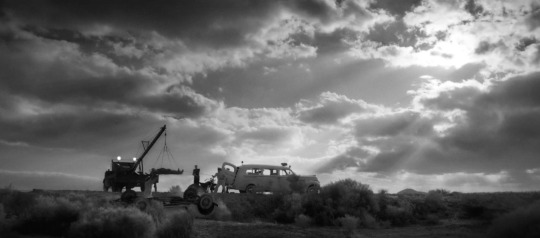
Director David Fincher Stars Gary Oldman, Lily Collins, Amanda Seyfried, Sam Troughton USA 2020 Language English, a tiny bit of German, some Latin sayings 2hrs 11mins Black & white
Lovely-to-look at but essentially pointless delve into ancient and very dull Hollywood gossip
The selling point for this film is, apparently, its contribution to the debate over who wrote Citizen Kane. Really? Really? After almost 80 years, is it vital to figure out exactly how much Herman Mankiewicz contributed to the script versus how much (if anything) Orson Welles put in? What about John Houseman, Roger Q Denny and Mollie Kent, all of whom the IMDB suggests made uncredited contributions to the screenplay but whose possible input is not acknowledged in this movie? (Other than Houseman supplying the stationery and surroundings for Mankiewicz to do the work.)

This all seems remarkably small beer – it’s not as if Mankiewicz was like one of the blacklisted writers whose names didn’t appear on the work they wrote. His name was in the movie, he did get the Oscar. He’s one of the reasons Kane is a terrific film, but then so were Joseph Cotton and Agnes Morehead (actors) and Gregg Toland (cinematographer) and Robert Wise (editor) and Bernard Hermann (composer) and everyone else who worked on the picture.
Likewise, are there really people out there desperate to revisit the accident gossip about William Randolph Hearst, especially as this film takes a fairly unexciting take on him? Maybe I’m wrong, maybe this is all the stuff of urgent debate. Maybe you’ve been smarting since 1999’s RKO 281told the same story, only from Welles’ side.
One thing the two films have in common is that they are littered with limeys. In RKO 281, we had David Suchet as Louis B Mayer and Fiona Shaw and Brenda Blethyn and as gossip column rivals Hedda Hopper and Louella Parsons and even Roger Allam as Walt Disney! In Mank, meanwhile, we’ve got Gary Oldman as the lead character, plus Tuppence Middleton as his wife Sara, Ferdinand Kingsley as Irving Thalberg, Charles Dance as Hearst and Tom Burke as Welles. It’s ridiculous. The only fully* British character is played by the less British-than-you-might-think Lily Collins, who indeed struggles with the accent.
New Cross’ Gary Oldman is 62 years old. Herman J Mankiewicz was only 55 when he died in 1953. The film doesn’t fudge this: Oldman’s Mankiewicz actually says. ‘I’m 43,’ presumably to the bafflement of the audience. And that’s during the 1940 segment of the movie – there are plenty of flashbacks to the 1930s when Mank was in his thirties. There’s no obvious attempt to de-age Oldman – I think we’re meant to accept that Mankiewicz’ alcoholism had taken a brutal toll.

So the plot is this: Mankiewicz, who has been injured in a car crash, is parked by Welles and Houseman on a ranch in the desert to write a script, tended to by a German nurse (Monika Gossmann) and a British typist (Collins). While working on the script, he flashes back to how he first met Hearst and Hearst’s mistress, actress Marion Davies (Amanda Seyfried), his friendship with them and troubled working relationship with MGM bosses Louis B Mayer and Irving Thalberg.
There’s something admirable perverse/ambitious about a glossy 2020 production that invites its audience to join with Mank in sneering at people who don’t know the difference between Upton Sinclair and Sinclair Lewis.** Upton Sinclair’s candidacy for the governorship of California indirectly triggers the crisis in the friendship between Mank and Hearst, which ultimately leads (in this telling of the story) to Kane. This section of the movie is both protracted yet incomplete and unconvincing.
Mankiewicz was by all accounts a big character. Unsurprisingly, then, directors chose grand hams to play him: John Malkovich in RKO 281 and Oldman here. For me, there’s no getting past how ridiculously old Oldman is for the role. The drinking and his reliance on a young secretary also reminded me of Oldman’s portrayal of Winston Churchill in The Darkest Hour, one of the most despicable and disgraceful films of recent times. But as Oldman performances go, this is one of the more likeable. Just not one that should ever have happened.

The best thing about the film by a very long way is the luscious black & white photography. The film plays around a bit – at times it hints a full pastiche of old movies, including the use of rear projection when the characters are in a car and having cue marks, the little circles on the top right of the screen to tell the projectionist to change the reel. At other times, though, it’s quite clearly using all the tricks and tools of 2020. It’s great work from cinematographer Eric Messerschmidt, whose previous director of photography stints have mostly been on TV.
The feeling I was mostly left with by this film is: why? What’s it for? To give a juicy role to an overindulged and miscast actor? To recreate the glory of lost Hollywood, just because we can? There have been far better recent excursions into the movie industry’s past: the Coen’s Hail, Caesar!, Trumbo or the TV show Feud, for instance. And, to be fair, there have been worse: this probably has the edge on Rules Don’t Apply. But I feel that if someone like me – who goes into this knowing who Thalberg and Houseman and Ben Hecht and Charles MacArthur and so on were – doesn’t really care, why would anyone else?
*Houseman was half-British and very much English educated. He’s played by Sam Troughton, who you could probably correctly guess is Patrick Troughton’s grandson.
**I’m happy to admit this is something I’ve always struggled with, having never read a word either wrote.
1 note
·
View note
Text
She’s Out of My League (2010)
Comedy, Romance
An airport security guard gets involved with a girl who’s very obviously of a higher caliber than himself, and schemes to make the relationship last as his friends and family watch along in disbelief. Kirk (Baruchel) was languishing in a dead-end job as an airport security agent when he somehow managed to earn the affections of the successful and drop-dead gorgeous Molly (Eve).
Even Kirk isn’t exactly sure what Molly sees in him, though he’s willing to do whatever it takes to make the relationship work. With his friends, family, and ex-girlfriend all watching stunned from the sidelines, Kirk discovers that he’ll have to work overtime in order to convince Molly that he’s worth hanging on to.
Director: Jim Field Smith
Writers: Sean Anders, John Morris
Stars: Jay Baruchel, Alice Eve, T.J. Miller, Mike Vogel, Nate Torrence, Lindsay Sloane, Kyle Bornheimer
youtube
►Cast:
Jay Baruchel→KirkAlice Eve→MollyT.J. Miller→StainerMike Vogel→JackNate Torrence→DevonLindsay Sloane→MarnieKyle Bornheimer→DylanJessica St. Clair→DebbieKrysten Ritter→PattyDebra Jo Rupp→Mrs. KettnerAdam LeFevre→Mr. KettnerKim Shaw→KatieJasika Nicole→WendyGeoff Stults→CamHayes MacArthur→RonAndrew Daly→Mr. FullerSharon Maughan→Mrs. McCleishTrevor Eve→Mr. McCleishAdam Tomei→RandyRobin Shorr→Tina JordanPatrick Jordan→BowlerTom Stoviak→Museum DirectorRick Applegate→“Plane Doctor”Heather Leigh→Flight AttendantChuck Aber→PilotJason McCune→Restaurant PatronYan Xi→KarenEvan Alex Cole→Scotty Reese (as Alex Cole)Joe Eberle→Hockey BartenderPhil Spano→Hockey CoordinatorJeff Adams→Hockey PlayerMila Cermak→Hockey PlayerMike Gaffney→Hockey PlayerTodd Gally→Hockey PlayerJim Gricar→Hockey PlayerRob Hofmann→Hockey PlayerJason C. Lewis→Hockey Player (as Jason Lewis)Ed Nusser→Hockey PlayerJory Rand→Hockey PlayerTom Rieck→Hockey PlayerMatthew Richert→Hockey Player (as Matt Richert)Joe Sager→Hockey PlayerLucia M. Aguirre→Flight AttendantElyse Alberts→Airline PassengerTony Amen→Airport PassengerNicholas Balzer→Airline PilotJoiel Bauschatz→Airline Ticket Agent / PedestrianRobert R. Bell→Airshow PatronAaron Bernard→First Class PassengerMinda Briley→Airport PassengerDavid Collihan→Airline Co-pilotSidney Crosby→SelfShawn Dando→ExtraJack Davis→Airport PatronRenee Downing→Birthday Party GuestMandy Ekman→StewardessJonathan Eldell→TravelerJackie Evancho→ExtraLamar Darnell Fields→Airport TravelerJim Fitzgerald→Pilot / Airline PassengerVal Gasior→Flight AttendantJosiah Hoffman→Pilot SmithKevin M. Jacobs→Market Square PatronCrystalann Jones→Bar PatronJeffrey Jones→Airport AdmirerWilliam Kania→Pittsburgh Penguins Hockey FanJon Knapp→Ex BoyfriendMichael Kolence→Party GuestJim Kuhn→Airline PassengerAlexis Kupka→SelfEric Leach→ExtraAlan Lee→TSA ArtStephanie Macdougall→Airport PassengerLorelei Mahoney→PassengerLaurie Mann→Hockey Crowd ExtraBuster Maxxwell→Flower sellerSean P. McCarthy→Airport TravelerLeslie McGuier→Airline ExtraTiffany Sander McKenzie→Airline PassengerChristopher Mele→Airport patronIan Michael→Restaurant GoerJeremy Moon→Airshow WorkerSusan Moran→Airline PassengerChristopher Nardizzi→Hockey FanPhil Nardozzi→Airline PassengerJillian O’Neil→Woman with SweaterDawn Renee→Flight AttendantPaul J. Rosenburg→BowlerDavid Santiago→Club PatronGaynelle W. Sloman→Party Guest / Driver on BridgeRay Sobieralski→PilotBrian E. Stead→WaiterRobert Stull→First Class PassengerJillian Vitko→Party GuestBlase Ward→Airport PatronJames Werley→Airport Person
Sources: imdb
The post She's Out of My League (2010) first appeared on TellUsEpisode.net.
from WordPress https://www.tellusepisode.net/shes-out-of-my-league-2010.html
1 note
·
View note
Text
Ray-Ban Aviator series
In terms of style, this is the Ray-Ban Aviator series, the single largest-selling sunglasses in history. The Ray-Ban aviator has also become the most classic style of sunglasses, which is a versatile and not picky face. The representative model of Ray-Ban is RB3025, and the representative model is the most well-known model. It does not mean that there is only 3025 in the pilot series.
Did you have a dream of flying when you were a child? Travel with us to the flight base in 1937, bring a Ray-Ban pilot, become a tidal "pilot", and be your true self!
The Ray-Ban pilot MOLLY continues the simple and classic design. The rose gold frame is paired with a new tea-pink gradient lens. The temple has the MOLLY signature and its representative crown logo, showing the joint name and trend attributes, showing a unique charm.
Ray-Ban pilot toad mirror Song Yuqi is the same style as a dog, and of course, the appearance is also essential! When I watched the movie "The Aviator" before, I felt that the little plum wearing aviator sunglasses was extremely handsome, so I decided to have the same style!
In fact, the so-called toad glasses are aviator sunglasses. Because this is the earliest sunglasses and the most classic sunglasses, no matter how the product shape is improved and innovated, every sunglasses company will reserve a place for the toad mirror. However, among the many toad mirror brands, the most well-known are Ray-Ban sunglasses.
The earliest American soldiers to wear goggles on the battlefield can be traced back to World War II. At that time, the proud American pilots would wear sunglasses called Ray-Ban, the proud five-star general Douglas. The sunglasses that MacArthur wore, at that time, these sunglasses were only owned by US military pilots, because they were a unique symbol of their pilots.
At present, this "Ray-Ban" sunglasses are still in service with various U.S. military aviation units. The biggest advantage of this sunglasses is that the lenses filter out the ultraviolet rays from the outside to the greatest extent. The shape of the lenses and the precise grinding technology can make the The object is not deformed, and it can reduce the eye fatigue of the pilot, and the image is rough and masculine, very masculine, and indeed very handsome. However, the modern goggles developed on its basis are different. Now, once the goggles equipped by the military around the world are separated from the training uniform, they will not be able to see where they are handsome. It reflects the needs of survival on the battlefield. .
Friends who like "Top Gun" like the editor of Maigoo must also be looking forward to this sequel after 35 years. The film is expected to be released in North America on July 2, 2021. Ray-Ban sunglasses, G The -1 pilot jacket is also back again. The top Navy pilot "Lone Ranger" Colonel Peter Mitchell, who has served in the film for more than 30 years, still sticks to his post, constantly breaking the limit of flying as a test pilot, and has been promoted to the Air Force Academy Instructor, train a young and vigorous pilot.
Sunglasses: During World War II, American aviators in leather jackets and Ray-Bans appeared around the world and became invisible advertisements for Ray-Ban sunglasses. The degree of love for sunglasses is self-evident, and after the war, Lei Ming's sunglasses quickly swept the world, and people are proud of having these sunglasses.
The brand of Ray-Ban, I don’t need to introduce more, the world’s first pilot sunglasses is the one it successfully developed, which belongs to the high-end brand. Although everyone is familiar with making sunglasses, their glasses are also good, and the optometry and various devices are very professional. As for the price, everyone has different opinions. If the budget is sufficient, it can be considered.
0 notes
